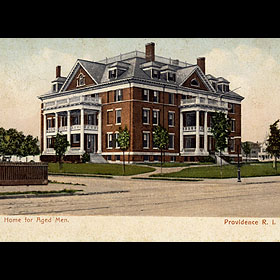
History
Founded in 1874, the Home For Aged Men's mission was to provide a "haven for indigent men over 60 years of age of American birth." The home, which was first located on 64 Point street, and then 63 Chestnut street, was funded by the organization's president Henry J. Steere. Steere, also a part owner of Wanskink mill, left $150,000 dollars in his will towards the construction of a larger building. It was with this money that the Home purchased the plot of land on Broad Street in 1891. Construction on the new building was complete by 1895. The building is included in the national register of historic places.
Changes
Over time, the home grew in size. The rear was enlarged several times and within few years, the building added on an infirmary. By 1908, the house had changed its name to The Home for Aged Men and Couples, allowing women to live there as well. The name of the home was later changed to "Steere House." In 1993, the property was bought by the Rhode Island Indian Council . They renamed the building "Algonquin house," Algonquin being the language of native Americans in the east. In 1995, renovations on the property began and they are still under way. The building is home to not only the Indian council, but a long list of non profit organizations , a photography studio, a lawyer's office, and a café.
Style
Mack Woodward describes the building as a "hip roof, Georgian Revival building with three colossal tetrastyle porticoes." The three and a half story brick building was built during a time of local enthusiasm around Italian renaissance style structures. Architectural historians say this classic revival was fueled by the styles of architects at the Chicago Worlds fair of 1893. Architect Stone Carpenter, and Willson built other buildings during the same time in a similar style. These include, Saint Maria's Home For Working Girls ( built in 1893 at 175 Governor Street), and the Rhode Island School for the Blind ( built in 1895 at 520 Hope Street). All three buildings have similar symmetrical plans, red brick walls, hipped roofs, classic details, and academic porches.
One employee of the Algonquin house says the building reminds her of Brown's Machado house, which was supposedly built during the same time as well.












